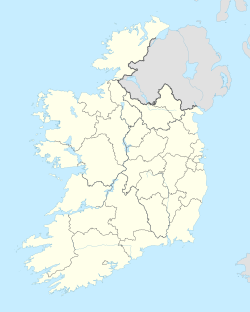Claregalway
Baile Chláir
Claregalway | |
|---|---|
Village | |
 Claregalway's friary (left), castle (centre) and bridge (right) | |
| Coordinates: 53°20′19″N 8°56′44″W / 53.3386°N 8.94542°W | |
| Country | Ireland |
| Province | Connacht |
| County | County Galway |
| Elevation | 12 m (39 ft) |
| Population (2022) | 1,632 |
| Irish Grid Reference | M370324 |
| As this is a Gaeltacht village, the Irish Baile Chláir is the only official name. The anglicized name Claregalway has no official standing. | |
Baile Chláir or Baile Chláir na Gaillimhe (anglicised Claregalway) is a Gaeltacht[2] village about 10 km north of Galway city in County Galway, Ireland. Claregalway was founded on the banks of the River Clare, hence the derivation of its name: Baile Chláir na Gaillimhe meaning "town on the Clare, in Galway". Claregalway lies within a Gaeltacht (Irish speaking) area and most locals traditionally spoke English only as a second language. The village is in a civil parish and barony of the same name.[2]
History
[edit]
Evidence of ancient settlement around the village include a number of ringfort, bawn, enclosure and crannog sites in the townlands of Claregalway, Cloonacauneen, Lydacan and Pollaghrevagh.[3]
Among the larger historical sites, within the village bounds on the banks of the River Clare, are Claregalway Friary,[4] founded in mid-13th century, and a Norman tower house dating to the 16th century.
According to the Annals of Connacht, O'Domnaill (of the O'Donnell's of Tírconnell) and Macwilliam Burke (of the Burkes of Mayo "burnt the town" of Claregalway in [5]
In 2001, a restoration of an old bridge over the old course of the River Clare was completed. These nine stone arches are above the level of the current road.[citation needed]

The civil parish of Claregalway (Baile Chláir) is approximately 50 km2 (19 sq mi) in area and spans 29 townlands.[6] Some of the larger townlands include Carnmore, Lydican, Loughgeorge and Cregboy. Lydican is notable as the origin of the Irish ancestors (Patrick Lynch) of Che Guevara. Lydican was the site of an O'Heyne Castle and the last of the chieftains, Connor Crone O Heyne, was living there in 1612. The lands of the O'Heyne chieftains were confiscated in the late 17th century and it was then that the Lynches took up residence there. The Lynches principal holdings were in the city of Galway.
Until September 2017, the village sat at the junction of the busy N17 and N18 national primary routes with over 27,000 vehicles having formerly passed through the village every day.[citation needed]
Demographics
[edit]The population of the village more than tripled in size in the 20 years between the 2002 and 2022.[7][1] The village is within the commuter belt of Galway City, with the 2022 census indicating that over 50% of people in the village had commutes of more than 15 minutes.[1]
Irish language
[edit]According to the 2022 census, there were 1,632 people living in Baile Chláir, of which less than 2% indicated that they spoke Irish every day outside of the education system.[1] This makes Baile Chláir one of the weakest Gaeltacht towns in the country, with the majority of the population speaking English.[citation needed]
Culture
[edit]Claregalway hosts a drama festival each year in March. Compántas Lir is an amateur drama group which is based in Claregalway and Carnmore.[8]
Education
[edit]Coláiste Bhaile Chláir is a co-educational secondary school in Claregalway. As of December 2024, it had an enrollment of over 1,270.[9]
Sport
[edit]Claregalway CLG is the local Gaelic Athletic Association (GAA) club.
The local basketball club participates in local leagues at underage through to senior level.[citation needed]
Claregalway Handball club opened a new-arena style handball alley in 2018.[10]
Notable residents
[edit]- Dana Rosemary Scallon, Irish singer and former MEP.[11]
References
[edit]- ^ a b c d "Interactive Data Visualisations: Towns: Baile Chláir". Census 2022. Central Statistics Office. Retrieved 30 September 2023.
- ^ a b Placenames Database of Ireland
- ^ Record of Monuments and Places - County Galway. Dublin: National Monuments and Historic Properties Service. 1997.
- ^ "Claregalway". Ireland West. Archived from the original on 29 June 2006. Retrieved 23 February 2007.
- ^ Annála Connacht – via celt.ucc.ie,
1469 [..] O Domnaill led a great army into Connacht to meet Macwilliam Burke. They both proceeded to Claregalway and burnt the town in spite of Thomond and Macwilliam, spent a night encamped there
- ^ "Civil Parish of Baile Chláir, Co. Galway". townlands.ie. Retrieved 3 July 2025.
- ^ "Baile Chláir (Ireland) Census Town". citypopulation.de. Retrieved 3 July 2025.
- ^ "Compantas Lir Drama Group". Archived from the original on 29 November 2007. Retrieved 15 July 2008.
- ^ "School - Coláiste Bhaile Chláir". gov.ie. Department of Education. 18 December 2024. Retrieved 3 July 2025.
- ^ "New Alley Officially Opened in Claregalway". gaahandball.ie. 27 March 2018. Archived from the original on 21 December 2019. Retrieved 21 December 2019.
- ^ "Claregalway Resident Dana Intends To Run For President". Galwaynews.ie. 22 September 2011. Archived from the original on 1 August 2012. Retrieved 28 September 2011.
External links
[edit]- Official website — a community-curated website for Claregalway
- Claregalway Castle website
- Irish language study 2006 (archived 2013)

